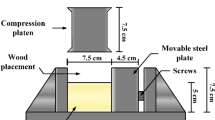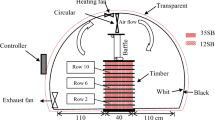Abstract
Collapse is an abnormal shrinkage which occurs in some species of wood during seasoning. It is due to physical collapse of the fibre cells, and is usually seen to occur in one or more discrete earlywood bands. Surface and internal checks can be induced by differential shrinkages arising from collapse in some parts of boards. It has already been established that the onset of collapse during seasoning is a temperature dependant process. To determine how this temperature sensitivity affects collapse induced checking in Australian eucalypts during seasoning, a stress and drying model was used to compare different drying strategies for avoiding collapse induced checking. The model demonstrated that the best way of avoiding collapse checking is to dry at temperatures below the “collapse threshold temperature” for the timber. It indicated that it may be possible to dry the timber at fully collapsing high temperatures and then recover the collapse by steam reconditioning, but this strategy requires more investigation.
Zusammenfassung
Kollaps ist eine unnormale Schwindung, die in einigen Holzarten beim Trocknen auftritt. Er wird verursacht durch Kollabieren von Faserzellen, üblicherweise in einem oder mehreren Frühholzbereichen. Oberflächliche und innere Risse können danach aufgrund differentiellen Schwindens in einigen Teilen des Schnittholzes induziert werden. Es wurde bereits früher aufgezeigt, daß dieser Vorgang temperaturabhängig ist. Um zu untersuchen, wie diese Temparaturabhängigkeit den Kollaps von australischem Eukalyptusholz auslöst, wurde ein Spannungs- und Trocknungsmodell benutzt, das es ermöglicht, verschiedene Trocknungsstrategien zu vergleichen und so die Rißbildung zu vermeiden. Die optimale Strategie ist demnach das Trocken unterhalb eines Temperatur-Schwellenwertes. Dadurch könnte es möglich sein, das Schnittholz zuerst unter Kollapsbildung bei hohen Temperaturen zu trocknen, dann aber den Kollaps durch Dampfbehandlung wieder rückgängig zu machen, so daß keine Rißbildung erfolgt. Dies erfordert jedoch noch weitere Untersuchungen.
Similar content being viewed by others
Abbreviations
- EC:
-
Creep strain
- Ei:
-
Instantaneous strain
- Em:
-
Mechano-sorptive strain
- Eu:
-
Unconfined shrinkage strain
- EW:
-
Earlywood
- LW:
-
Latewood
- MC:
-
Moisture content
- FSP:
-
Fiber saturation point
References
Booker, J. D. 1994a: Acoustic emission related to instantaneous strain in Tasmanian eucalypt timber during seasoning. Wood Sci. Technol. 28: 249–259
Booker, J. D. 1994b: Unpublished results
Booker, J. D. 1994c: The use of acoustic emission in improving hardwood timber seasoning productivity. PhD thesis, Faculty of Engineering, University of Tasmania, Australia
Chafe, S. C.;Barnacle, J. E.;Hunter, A. J.;Ilic, J.;Northway, R. L.;Rozsa, A. N. 1992: Collapse: an introduction. CSIRO Division of Forest Products, Melbourne, Australia
Doe, P. E.; Oliver, A. R.; Booker, J. D. 1994: A non-linear strain and moisture content model of variable hardwood drying schedules. Paper presented at 4th IUFRO International Wood Drying Conference, August 9–13, Rotorua New Zealand
Hillis, W. E.;Rozsa, A. N. 1978: The softening temperatures of wood. Holzforschung 32: 68–73
Innes, T. C. 1995: Stress model of a wood fibre in relation to collapse. Wood Sci. Technol. 29: 363–376
Innes, T. C. 1996a: Collapse free pre-drying ofEucalyptus regnans F. Muell. Holz als Roh-Werkstoff 53: 403–406
Innes, T. C. 1996b: Collapse and internal checking in the latewood ofEucalyptus regnans F. Muell. Wood Sci. Technol.in press
Kauman, W. G. 1964: Cell Collapse in Wood Part 1: Process Variables and Collapse Recovery. Holz Roh-Werkstoff 22(5): 183–196
Oliver, A. R. 1991: A model of the behaviour of wood as it dries (with special reference to eucalypt materials). Research report CM91-1, Civil and Mechanical Engineering Department, University of Tasmania
Tiemann HD 1915: Principles of kiln drying. Lumber World Review Jan 15–Sept 25
Wilkins, A. P.;Wilkes, J. 1987: Observations on the mechanism of collapse in wood. Journal of the Institute of Wood Science 11(2): 89–92
Wu Qinglin 1989: An investigation of some problems in drying of Tasmanian eucalypt timbers. MEngSci thesis, University of Tasmania
Author information
Authors and Affiliations
Rights and permissions
About this article
Cite this article
Innes, T.C. Pre-drying of collapse prone wood free of surface and internal checking. Holz als Roh-und Werkstoff 54, 195–199 (1996). https://doi.org/10.1007/s001070050165
Issue Date:
DOI: https://doi.org/10.1007/s001070050165




